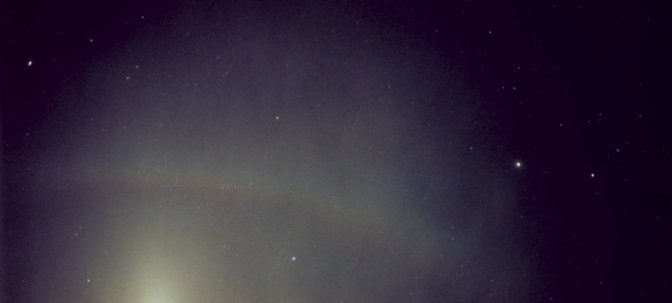SKYLIGHTS

Photo of the Week.. A part of the 22-degree halo, caused
by moonlight refracting through ice cyrstal clouds, surrounds the Moon.
Saturn shines off to the right.
Astronomy news for the week starting Friday, March 29, 2002.
Prepared by Jim
Kaler.
The Moon moves through its waning gibbous phase during most of the
week, finally achieving last or third quarter on Thursday, April 4,
at which time we see a "half moon," demonstrating one of the many
curious nomenclature anomalies in astronomy. The "half moon"
refers to the half-illuminated disk, while the "quarter moon"
refers to the quartering of the lunar orbit. The "first quarter"
occurs when the Moon is 90 degrees around its orbit from the new
phase, the third quarter when it is 270 degrees around. Full Moon
could just as well be called the "second quarter," though the term
is never used. With the Sun just past the vernal equinox in
Pisces, this third quarter Moon will be the most southerly of the
year and will appear just past the winter solstice in Sagittarius.
A couple days before the third quarter, the night of Monday, April
1, for those in North America the Moon will lie just up and to the
right of Antares in Scorpius and almost on top of Dschubba (Delta Scorpii). Keep
your eye on the star, as it is brightening. Turning into a "B-
emission" star, Dschubba is now nearly first magnitude, and perhaps
will actually rival Antares. The star is doing what Gamma Cassiopeiae did over 70 years
ago, and will probably someday settle back to normal.
Venus is now brilliant and unmistakable in evening twilight. As
April begins, this second planet out from the Sun "crosses the
line" and sets just as twilight formally ends. Above it is reddish
Mars, which sets just before 10 PM. Higher still is Saturn in Taurus. As the month ends, Sunday,
March 31, the ringed planet will pass four degrees north of the
first magnitude star Aldebaran
in Taurus. Saturn, the brighter of the two and a bit yellowish in
color as a result of reflection of sunlight from its cloudy
surface, makes a fine contrast with coolish Aldebaran's more orange
color. Higher still, and not setting until after 1 AM, is Jupiter
in Taurus.
As March gives way to April, the winter stars escape to the west.
Sirius, which dominates winter
with its white sparkle, leads the eye to the south and the ancient
constellation Argo, the Ship.
Almost immediately below Sirius those who live below about 35
degrees south latitude can see the sky's second brightest star, Canopus, in Carina, Argo's keel. Between, and a bit to the east
of, the two stars, find Puppis, the
Stern, and more to the east Vela,
the Sails. Directly above Sirius is the dim modern constellation
Monoceros, the Unicorn, and to the
west, Lepus, the Hare, Orion the
Hunter's smallish prey.







